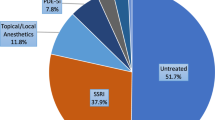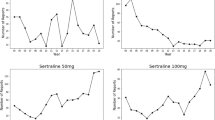Abstract
Lifelong premature ejaculation (LPE) may have heritable components. Selective serotonin reuptake inhibitors have been proven effective in prolonging intravaginal ejaculation latency time (IELT). Given that serotonergic pathways are involved in the ejaculation mechanism, we aimed to investigate whether His452Tyr, also known as the C1354T (RS6314) polymorphism of the 5-HT2A receptor, contributes to LPE pathogenesis and IELT differences among patients with LPE. Dutch Caucasian men with LPE (n = 65) attending the Outpatient Department of Neurosexology, HagaZiekenhuis for drug treatment for LPE in 2009 were selected and included in this case–control study. IELT during coitus was measured using a stopwatch, and all men were genotyped for the His452Tyr polymorphism. Analysis of variance (ANOVA) was performed to determine the association between the genotypes and IELTs. Mean IELTs with standard deviations were 29.7 (±20.9), 31.5 (±14.7), and 26.0 s, and the frequencies were 83.1%, 15.4%, and 1.5% for the CC, CT, and TT groups, respectively, with an average IELT of 29.9 s. No difference in mean IELT was observed between these groups. In the affected group, the frequencies of alleles C and T were 90.8% and 9.2%, respectively; whereas those among randomly selected European Caucasian male controls (n = 503) from the CEPH database were of 92.0% and 8.0%, respectively. No significant difference was observed between the groups. Therefore, no correlation was found between the His452Tyr polymorphism and IELT distribution in patients with LPE.
This is a preview of subscription content, access via your institution
Access options
Subscribe to this journal
Receive 8 print issues and online access
$259.00 per year
only $32.38 per issue
Buy this article
- Purchase on Springer Link
- Instant access to full article PDF
Prices may be subject to local taxes which are calculated during checkout

Similar content being viewed by others
References
Althof SE, McMahon CG, Waldinger MD, Serefoglu EC, Shindel AW, Adaikan PG, et al. An update of the International Society of Sexual Medicine’s guidelines for the diagnosis and treatment of premature ejaculation (PE). Sex Med. 2014;2:60–90.
Serefoglu EC, Yaman O, Cayan S, Asci R, Orhan I, Usta MF, et al. Prevalence of the complaint of ejaculating prematurely and the four premature ejaculation syndromes: results from the Turkish Society of Andrology Sexual Health Survey. J Sex Med. 2011;8:540–8.
Gao J, Zhang X, Su P, Liu J, Xia L, Yang J, et al. Prevalence and factors associated with the complaint of premature ejaculation and the four premature ejaculation syndromes: a large observational study in China. J Sex Med. 2013;10:1874–81.
Schapiro B. Premature ejaculation, a review of 1130 cases. J Urol. 1943;50:374–9.
Waldinger MD, Rietschel M, Nöthen M, Hengeveld MW, Olivier B. Familial occurrence of primary premature ejaculation. Psychiatr Genet. 1998;8:37.
Janssen PK, van Schaik R, Zwinderman AH, Olivier B, Waldinger MD. The 5-HT1A receptor gene C (1019) G polymorphism influences the intravaginal ejaculation latency time in Dutch Caucasian men with lifelong premature ejaculation. Pharmacol Biochem Behav. 2014;121:184–8.
Janssen PK, van Schaik R, Olivier B, Waldinger MD. The 5-HT2C receptor gene Cys23Ser polymorphism influences the intravaginal ejaculation latency time in Dutch Caucasian men with lifelong premature ejaculation. Asian J Androl. 2014;16:607–10.
Waldinger MD, Zwinderman AH, Olivier B. SSRIs and ejaculation: a double-blind, randomized, fixed-dose study with paroxetine and citalopram. J Clin Psychopharmacol. 2001;6:556–60.
Li J, Yuan H, Bai Y, Pu C, Tang Y, Dong Q, et al. Dapoxetine for premature ejaculation: and updated meta-analysis of randomized controlled trials. Clin Ther. 2014;12:2003–14.
Carhart RL, Nutt DJ. Serotonin and brain function: a tale of two receptors. J Psychopharmacol. 2017;31:1091–120.
Blier P, Szabo S. Potential mechanisms of action of atypical antipsychotic medications in treatment-resistant depression and anxiety. J Clin Psychiatry. 2005;66:30–40.
Serefoglu EC, McMahon CG, Waldinger MD, Althof SE, Shindel A, Adaikan G, et al. An evidence-based unified definition of lifelong and acquired premature ejaculation: report of the second International Society for Sexual Medicine ad hoc Committee for the definition of premature ejaculation. J Sex Med. 2014;2:41–59.
Meucci MA, Marsh S, Watters JW, McLeod HL. CEPH individuals are representative of the European American population: implications for pharmacogenetics. Pharmacogenomics. 2005;6:59–63.
CEPH database. Paris: Fondation Jean Dausset RS6314 SNP from European Caucasian population. 1990. http://www.cephb.fr/en/collectionsBio.php. Accessed Jul 2018.
Waldinger MD, Hengeveld MW, Zwinderman AH. Paroxetine treatment of premature ejaculation: a double-blind, randomized, placebo-controlled study. Am J Psychiatry. 1994;151:1377–9.
Miller SA, Dykes DD, Polesky HF. A simple salting out procedure for extracting DNA from human nucleated cells. Nucleic Acids Res. 1988;16:1215.
Ozaki N, Rosenthal NE, Pesonen U, Lappalainen J, Feldman-Naim S, Schwartz PJ, et al. Two naturally occurring amino acid substitutions of the 5-HT2A receptor: similar prevalence in patients with seasonal affective disorder and controls. Biol Psychiatry. 1996;40:1267–72.
Waldinger MD, Zwinderman AH, Olivier B, Schweitzer DH. Geometric mean IELT and premature ejaculation: appropriate statistics to avoid overestimation of treatment efficacy. J Sex Med. 2008;5:492–9.
Waldinger MD, Zwinderman AH, Olivier B, Schweitzer DH. The majority of men with lifelong premature ejaculation prefer daily drug treatment: an observation study in a consecutive group of Dutch men. J Sex Med. 2007;4:1028–37.
Acknowledgements
The authors thank Marcel D. Waldinger MD Ph.D., who died on May 1, 2019, for his contribution to this study. The authors also thank the Department of Complex Genetics of Utrecht University for making their laboratory available.
Funding
This study was made possible by funding from Prof. Dr. Marcel Waldinger foundation, The Netherlands.
Author information
Authors and Affiliations
Contributions
PKCJ carried out the experiments and took full responsibility for data processing and methodology. KHH took the lead in writing the paper. JJR helped shape the research, analysis, and paper. FV provided critical feedback.
Corresponding author
Ethics declarations
Competing interests
FV supervises two Ph.D. students who are employed by F. Hoffmann la Roche Ltd. (Basel, Switzerland; Welwyn Garden City, UK). The topics of their Ph.D. theses are not related to the current article. FV has not received any fees or reimbursements for his supervision.
Additional information
Publisher’s note Springer Nature remains neutral with regard to jurisdictional claims in published maps and institutional affiliations.
Rights and permissions
About this article
Cite this article
van Raaij, J.J., Hua, K.H., de Vries, F. et al. His452Tyr 5-HT2A polymorphism and intravaginal ejaculation latency time in Dutch men with lifelong premature ejaculation. Int J Impot Res 35, 103–106 (2023). https://doi.org/10.1038/s41443-021-00489-6
Received:
Revised:
Accepted:
Published:
Issue Date:
DOI: https://doi.org/10.1038/s41443-021-00489-6
This article is cited by
-
Correspondence on: His452Tyr 5-HT2A polymorphism and intravaginal ejaculation latency time in Dutch men with lifelong premature ejaculation
International Journal of Impotence Research (2023)



